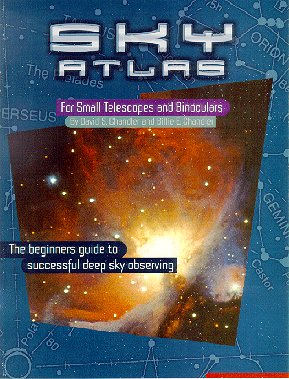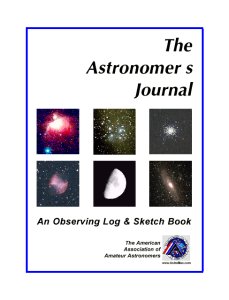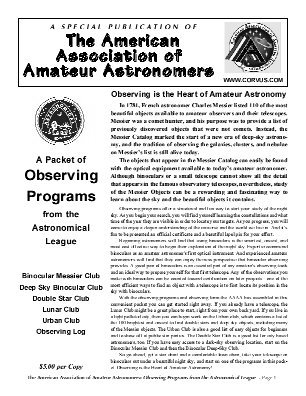The beginners guide to
successful deep sky observing
 By David and Billie Chandler By David and Billie Chandler
Sky Atlas for Small Telescopes and Binoculars was written to fill a special need. More 2.5"
(60mm) telescopes are sold than any other kind, but most star atlases assume at least a 6" or 8" telescope.
We, of course, recommend that beginners start with a larger telescope, if possible, but
the fact is most people
start small. If you own a small telescope already, you should supplement it with a pair of binoculars, learn
to use the equipment you have, and start spending time under the stars. Featuring
nearly 200 deep sky objects
selected for visibility in a 2.5" telescope or simple binoculars, this atlas is designed to help you do
just that.
The atlas format is similar to the classic Norton's Star Atlas. Think of an orange as the whole
sphere of the sky. Slice off the two ends, then cut the remainder of the orange into six vertical slices. The first
circular map covers the north polar region, six vertical segments spaced around the equator cover the majority
of the sky, and the final circular map covers the south polar region. (The circular maps are stereographic projections
and the vertical segment maps are transverse Mercator projections. Both projections preserve shapes well.) The
maps highlight the Milky Way with representation digitized from a master Milky Way map by the renowned space artist,
Don Davis. You will find this to be a great improvement over Milky Way outlines in most other atlases. Deep sky
objects, including a careful selection of double stars and other stars of special interest, are highlighted in
blue. Constellation figures are drawn to match the figures on The Night Sky.
 The Astronomer's Journal, The Astronomer's Journal,
An Observing Log and Sketch Book
We feel that The Astronomer's Journal is something that every
amateur astronomer will benefit from. We all know the virtues of writing down what you see and keeping accurate
records. The Astronomer's Journal makes it that much easier for you to get started
down the path of better observing in an organized and economical way.
Once you start using it, you'll wonder what you ever did without it.
Order yours today!
Clear skies! Good Observing! Fight light pollution!
Observing is the Heart
of Amateur Astronomy
 With the observing programs the AAAA has assembled in our
convenient package, you can get started on your next observing
project right away. If you already have a telescope, the Lunar Club
might be a great place to start, right from your own back yard. If
you live in a light polluted city, then you can begin work on the
Urban club, which contains a list of the 100 brightest and easiest
to find double stars and deep sky objects, including many of the
Messier objects. The Urban Club is also a good list of easy objects
for beginners and to show off at public star parties. The Double
Star Club is a good list for city based astronomers, too. If you
have easy access to a dark-sky observing location, start on the
Binocular Messier Club and then the Binocular Deep-Sky Club. With the observing programs the AAAA has assembled in our
convenient package, you can get started on your next observing
project right away. If you already have a telescope, the Lunar Club
might be a great place to start, right from your own back yard. If
you live in a light polluted city, then you can begin work on the
Urban club, which contains a list of the 100 brightest and easiest
to find double stars and deep sky objects, including many of the
Messier objects. The Urban Club is also a good list of easy objects
for beginners and to show off at public star parties. The Double
Star Club is a good list for city based astronomers, too. If you
have easy access to a dark-sky observing location, start on the
Binocular Messier Club and then the Binocular Deep-Sky Club.
AAAA Observers-Pak
The Packet of AL Observing Programs tells you what to look
for. Use the Sky Atlas for Small Telescopes and Binoculars to
locate and find objects. The Astronomer's Journal makes a great place to record those
observations as you work on each certificate.
The price for each
OBSERVERS-PAK
from
AstroMax is
$27.00

Click
HERE
to order now |